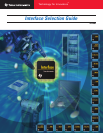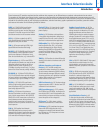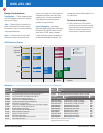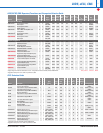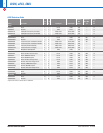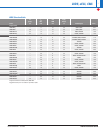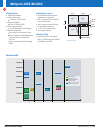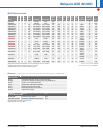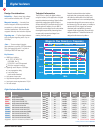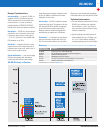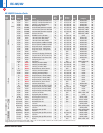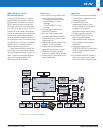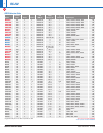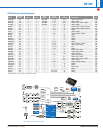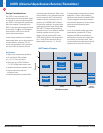
Texas Instruments 4Q 2006 Interface Selection Guide
Texas Instruments (TI) provides complete interface solutions that empower you to differentiate your products and accelerate time-to-market.
Our expertise in high-speed, mixed-signal circuits, system-on-a-chip integration and advanced product development processes ensures you will
r
eceive the silicon, support tools, software and technical documentation to create and deliver the best products on time and at competitive prices.
I
ncluded in this selection guide you will find design considerations, technical overviews, graphic representation of portfolios, parametric tables
a
nd resource information on the following families of devices:
LVDS: (p. 4) TIA/EIA-644A specification
d
esigned for differential transmission
delivering signaling rates into the Gbps range
and power in the mW range with low EMI to
the telecommunication and consumer markets.
xECL: (p. 4) Emitter coupled logic (xECL),
high-speed differential interface technology
designed for low jitter and skew.
CML: (p. 4) Current-mode logic (CML), high
speed differential interface technology.
M-LVDS: (p. 8) TIA/EIA-899 specification with
all the benefits of LVDS applicable to multi-
point bus architecture in backplanes. Used
often for clock distribution, e.g. AdvancedTCA.
Digital Isolators: (p. 10) The new ISO72x
high-speed digital isolators use state-of-the-art
integrated capacitive coupling and silicon-
dioxide isolation barrier to provide up to
150-Mbps signaling rate with only 1-ns jitter,
best-of-class noise immunity and high reliability.
RS-485/422: (p. 11) Robust TIA/EIA-485 and
TIA/ EIA-422 specifications specially designed
for harsh, industrial environments transmitting
a differential signal up to 50 Mbps or 1.2 km.
RS-232: (p. 13) TIA/EIA-232 specification
defining single-ended interface between data
terminal equipment (DTE) and data circuit-
terminating equipment (DCE).
UARTs: (p. 16) Universal Asynchronous
Receiver/T
ransmitters are the key logic compo
-
nent of serial communication utilizing RS232,
RS485/422 or LVDS transceivers to transmit or
receive between remote devices performing
parallel
to serial conversion in the transmit
process and serial to parallel conversion in the
receive process.
CAN: (p. 18) Controller Area Network
(ISO11898) specification commonly used in
automotive and industrial applications describes
differential signaling at a rate up to 1 Mbps on
a 40-meter bus with multipoint topology.
CardBus Power Switches: (p. 34) The
C
ardBus controller uses the card detect and
voltage sense pins to determine a PC card’s
voltage requirements and then directs the
PCMCIA power switch to enable the proper
voltages. Standard PC cards require that V
CC
be switched between ground, 3.3 V, and 5 V,
while VPP is switched between ground, 3.3 V,
5 V, and 12 V. CardBay sockets have the stan-
dard requirements for V
CC
, but require ground,
3.3 V, and 5 V to VPP, and ground, 1.8 V, or 3.3
V to V
CORE
. Other PC card applications may
simply not need 12 V or VPP while still having
the standard requirements for V
CC
. Therefore,
consider the voltage requirements of the
application when selecting a PCMCIA
power switch.
1394: (p. 36) IEEE 1394 (FireWire
®
) high-speed
interconnection enables simple, low-cost,
high-bandwidth, real-time data connectivity
between computers, peripherals and consumer
electronics.
GTLP: (p. 39) Gunning transceiver logic plus
(GTLP) derived from the JEDEC JESD8-3 GTL
standard is a reduced-voltage-swing
technology designed for high-speed interface
between cards operating at LVTTL logic levels
and backplanes operating at GTLP signal levels.
VME: (p. 41)
The VMEbus™ is a standardized,
64-bit, backplane architecture that is coordi-
nated and controlled by VITA. VME is used
extensively in military
, industrial and aerospace
applications.
Clock Distribution Circuits: (p. 42)
TI offers both single-ended and differential
clock buffers that perform from below 200 MHz
up to 3.5 GHz in a variety of fan-out options. In
addition to simple option for customers needing
differential signals (LVPECL) and single-ended
signals (LVTTL/LVCMOS) from the same device.
FlatLink™ 3G: (p. 19) A new family of serial-
i
zers and deserializers designed for mobile
phone displays.
SerDes: (p. 20) Serializers and deserializers
in the gigabit range designed to bridge large
numbers of data bits over a small number of
data lines in telecommunication applications.
DVI/PanelBus™: (p. 22) The Digital Visual
Interface Specification, DVI, is an industry
standard developed by the Digital Display
Working Group (DDWG) for high-speed digital
connection to digital displays. DVI uses
transition-minimized DC balanced (TMDS)
data signaling.
TMDS: (p. 24) Transition minimized differential
signaling is the electrical interface used by DVI
and HDMI.
USB Hub Controllers and Peripheral
Devices:
(p. 25) The USB standard was
established to make connecting PCs, peripher-
als and consumer electronics flexible and easy.
The hub controller manages USB port connect/
disconnect activities and a peripheral controller
enables USB connectivity of a peripheral
device to either a host or hub.
USB Port Protection: (p. 26) Transient voltage
suppressor protects USB 1.1 devices from ESD
and electrical noise transients.
USB Power Managers: (p. 27)
TI products,
like TPS204xA and TPS205xA, are designed to
meet all the USB 1.0 and 2.0 requirements for
current-limiting and power switching to reliably
control the power on the voltage bus.
PCI Express
®
: (p. 29)
A robust, scalable,
flexible and cost-effective I/O interconnect.
PCI Bridges: (p. 33) A peripheral component
interconnect (PCI) bridge provides a high-
performance connection path between either
two PCI buses or a PCI component and one or
more DSP devices.
Interface Selection Guide
Introduction
3
➔



